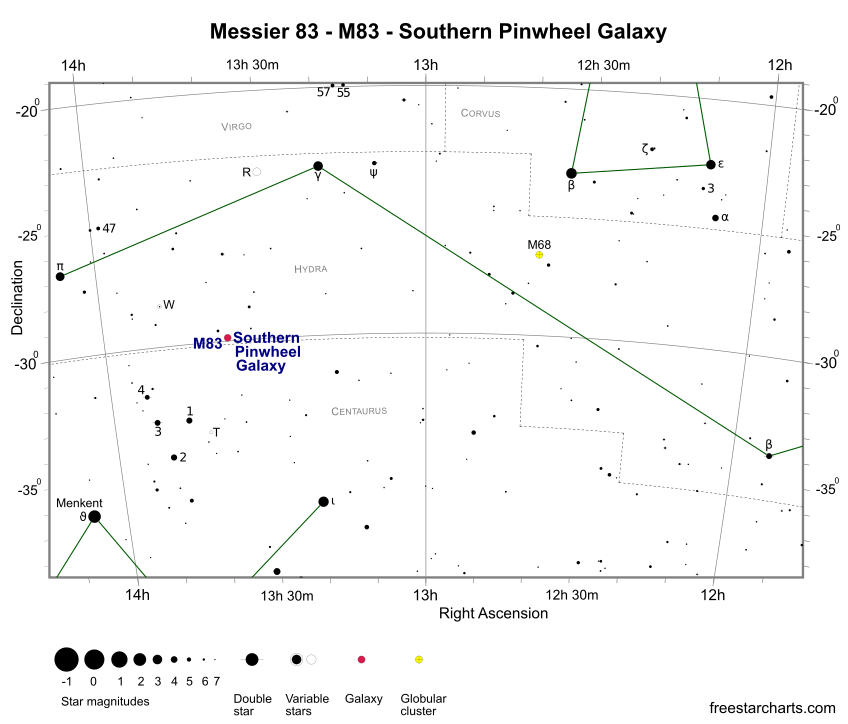M83, also known as the Southern Pinwheel Galaxy, is a barred spiral galaxy approximately 14.7 million light-years distant in the eastern section of Hydra. It's one of the closest barred spirals, a showpiece galaxy and the finest example of its type in the sky. With an apparent magnitude of +7.5, this galaxy is visible with 7x50 or 10x50 binoculars under dark skies as a patch of light with a bright centre.
At a declination of 30 degrees south, M83 is best seen from Southern Hemisphere or equatorial regions during the months of April, May and June. It's the southernmost galaxy in the Messier list and therefore a difficult object from mid-northern latitudes, that never climbs particularly high above the horizon.
Although a relatively bright galaxy, M83 can be tricky to find since it's located in an area of sky devoid of bright stars. It's positioned 6 degrees south of the mid-point of an imaginary line connecting γ Hydrae (mag. +3.0) with π Hydrae (mag. +3.3). M83 was discovered by Nicholas Louis de Lacaille at the Cape of Good Hope in South Africa on February 23, 1752 and was added by Charles Messier to his catalogue on February 17, 1781.


Finder Chart for M83 - pdf format (credit:- freestarcharts)
M83 is a superb telescope galaxy. Small 80mm (3.1-inch) refractors reveal a bright core surrounded by a diffuse nebula that covers about 1/3 the apparent diameter of the full Moon. Don't be afraid to push up the magnification, this galaxy will take it. For example, through 150mm (6-inch) scopes at high powers, it's a splendid sight with a bright-condensed nucleus surrounded by a large envelope of fainter nebulosity. Also visible on nights of good seeing are dark dust patches surrounding the nucleus. Through larger 250mm (10-inch) reflectors, M83 is a stunning object with well-formed spiral arms, numerous dust lanes and the distinct central bar all visible.
M83 is part of the M83 group, which also includes peculiar radio galaxy Centaurus A (NGC 5128) and unusual galaxy NGC 5253. In the last 100 years, six supernovae have been observed in M83 (1923A, 1945B, 1950B, 1957D, 1968L and 1983N). This makes M83 a popular target for amateur supernovae hunters. When observing the galaxy, it's not a bad idea to compare the view against an archive photograph or image. If you happen to see a "new" star, you may have made a supernova discovery.
M83 Data Table
| Messier | 83 |
|---|---|
| NGC | 5236 |
| Name | Southern Pinwheel Galaxy |
| Object Type | Barred spiral galaxy |
| Classification | SAB (s) c |
| Constellation | Hydra |
| Distance (light-years) | 14.7 Million |
| Apparent Mag. | 7.5 |
| RA (J2000) | 13h 37m 00s |
| DEC (J2000) | -29d 52m 04s |
| Apparent Size (arc mins) | 12.9 x 11.5 |
| Radius (light-years) | 27,500 |
| Number of Stars | 40 Billion |
| Notable Feature | Six supernovae have been observed in M83 |